Do you know how many types of nosings for stair are commonly available? According to statistics, most people prioritize style when choosing nosing types.
However, each type of stair nosing has distinct characteristics. Additionally, their sizes should adhere to international standards, which is often overlooked by many people.
Now, let's explore the various types of stair nosings and the considerations behind them through this professional article.

What is Stair Nosing?
Stair nosing, a crucial component in architectural design and safety, refers to the specialized strip attached to the front edge of each step in a staircase. This essential feature, crafted from diverse materials like metal, wood, rubber, aluminum, and vinyl, plays a pivotal role in enhancing the durability and safety of stairs.
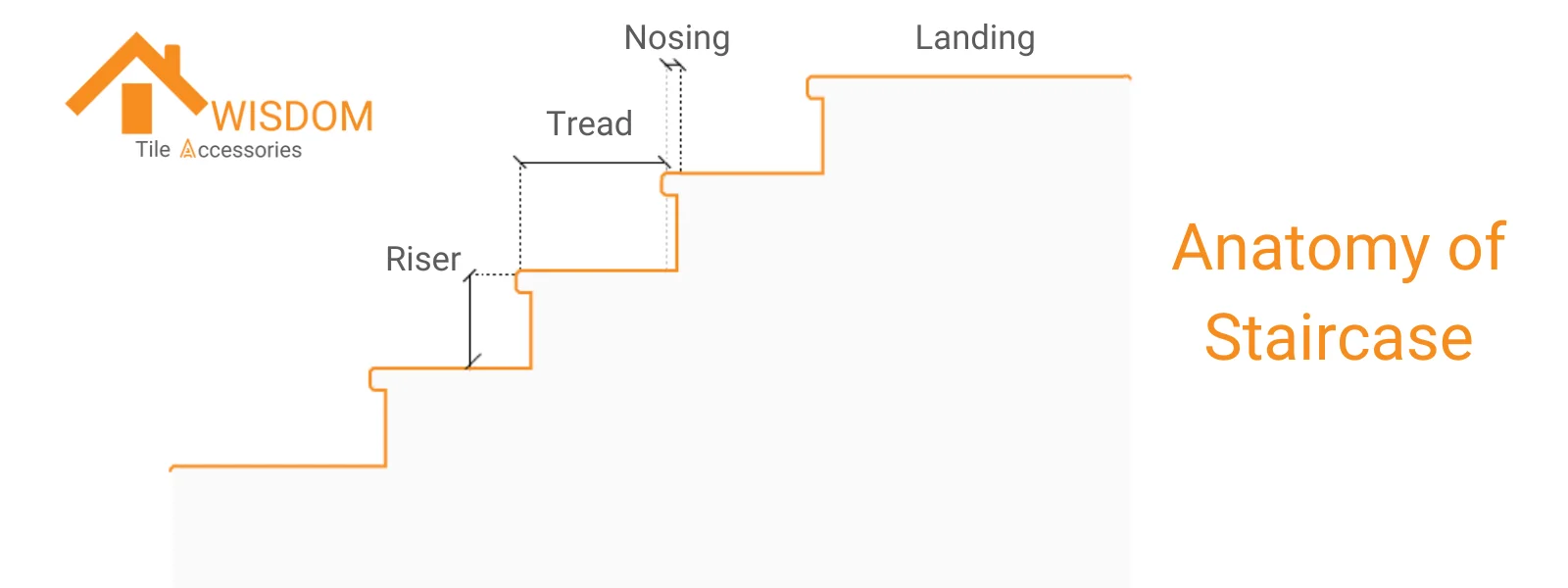
What is the purpose of a nosing?
The primary function of stair nosing is to enhance the safety and accessibility of a staircase. By extending slightly beyond the edge of each tread, nosing creates additional surface area, offering ample space for the full foot to step securely. This extra space is particularly beneficial for taller individuals, providing more comfort as they ascend or descend the stairs.
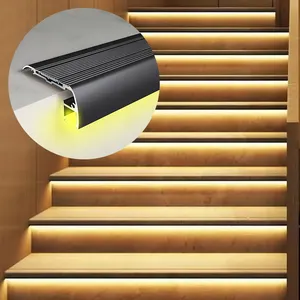

Moreover, beyond its functional benefits, stair nosing contributes to the aesthetic appeal of staircases, offering a polished and finished look. Its versatility in material and design makes it suitable for various types of staircases, reinforcing the steps against wear and tear while providing additional grip to prevent slips and falls.
What is the standard nosing for stairs?
In discussing the standard nosing for stairs, it's essential to adhere to the specifications outlined by the International Building Code (IBC).
According to IBC Section 1011.5.5, "Nosings shall have a curvature or bevel of not less than 1/16 inch (1.6 mm) but not more than 9/16 inch (14.3 mm) from the foremost projection of the tread."
Furthermore, the risers must be "solid and vertical or sloped under the tread above from the underside of the nosing above at an angle not more than 30 degrees (0.52 rad) from the vertical."

The IBC also mandates in Section 1011.5.5.1 that the leading edge of treads should "project not more than 1 and 1/4 inches (32 mm) beyond the tread below" and insists on the uniformity of these projections as per Section 10115.52.
Moreover, while risers are generally required to be solid, exceptions are detailed in Section 1011.5.53, noting circumstances under which solid risers are not obligatory, such as in certain occupancy classifications and stairway types.
By incorporating these standards, we can ensure that stair design prioritizes safety and compliance with established building codes.

Form 1: A quick comparison of various types of nosing
Type of Nosing | Description | Aesthetic Value | Practicality | Common Usage |
|---|---|---|---|---|
Full-Round Nosing | Curves around the step, often used on landing steps. | High (especially in grand staircases) | Lower slip protection | Grand-scale staircases |
Half-Round (Bull Nose) | Smooth and curved, half-moon shape. Flat surface. | Chic and subtle elegance | Moderate practicality | Common in various stair designs |
Pencil Round Nosing | Classic style, often seen in traditional designs. | Adds a classic touch | Less common in modern architecture | Wooden staircases |
Square Edge Nosing | Protruding edge, designed to prevent dents and scratches. | Clean lines, beautiful aesthetic | High functionality | Blends functionality with design |
No Overhang (Flush) | Flush alignment with riser, no overhanging parts. Typically crafted from wood, simple yet elegant appearance. | Minimalist and cohesive look | Easy to install | Modern, minimalist staircases |
THE 5 MAIN TYPES OF NOSING
The most common types of nosing are:
1. Full-Round Stair Nosing




Full round nosing, often used only on landing steps, curves around the step. While offering less slip protection, this type of nosing for stairs is favored for its aesthetic value, especially in grand-scale staircases, prioritizing appearance over practicality.
2. Half-Round Stair Nosing (Bull Nose)


The character of the half-round or bullnose is that its smooth and curved design offers a chic appeal. Its surface is usually flat, and it takes the shape of a half-moon, which adds a subtle elegance to stair edges.
Among them, metal bullnose for stairs are favored by many construction professionals.
3. Pencil Round Stair Nosing


Pencil round is a classic style, and often used in traditional designs. You can see it on the wooden stair. This nosing type is less common in modern architecture but adds a classic touch to staircases.
4. Square Edge Stair Nosing


The square edge nosing is identifiable by its protruding edge, designed to prevent dents and scratches. This style adds clean lines and a beautiful aesthetic to staircases, blending functionality with design.
5. No Overhang Stair Nosing (Flush Stair Nose)


The no overhang is renowned for its minimalist aesthetic. Due to its flush alignment with the riser and the absence of any overhanging parts, it exhibits a singular and stylish structure. This type of nosing is typically crafted from wood, making it easy to install. Its simple yet elegant appearance gives the staircase a cohesive look.
How to Choose the Right Stair Nosing Types?
Types of Material for Stair Nosings
Metal Stair Nosing Types


Metal stair nosings are currently one of the most popular products. Due to their minimalist and stylish design, as well as their corrosion resistance, they have gained popularity among many people.
Whether used in homes or business buildings, they can meet many people's needs. These types of nosing are mainly divided into stainless steel stair nosings and aluminum alloy stair nosings.
The differences between them are not significant, but aluminum alloy tends to have a lower cost, and it offers a greater variety of styles and colors.
Stainless steel may come at a slightly higher price, but its corrosion resistance is stronger, resulting in a longer lifespan. This makes it particularly suitable for large-scale construction projects, as a long lifespan can reduce subsequent maintenance costs.
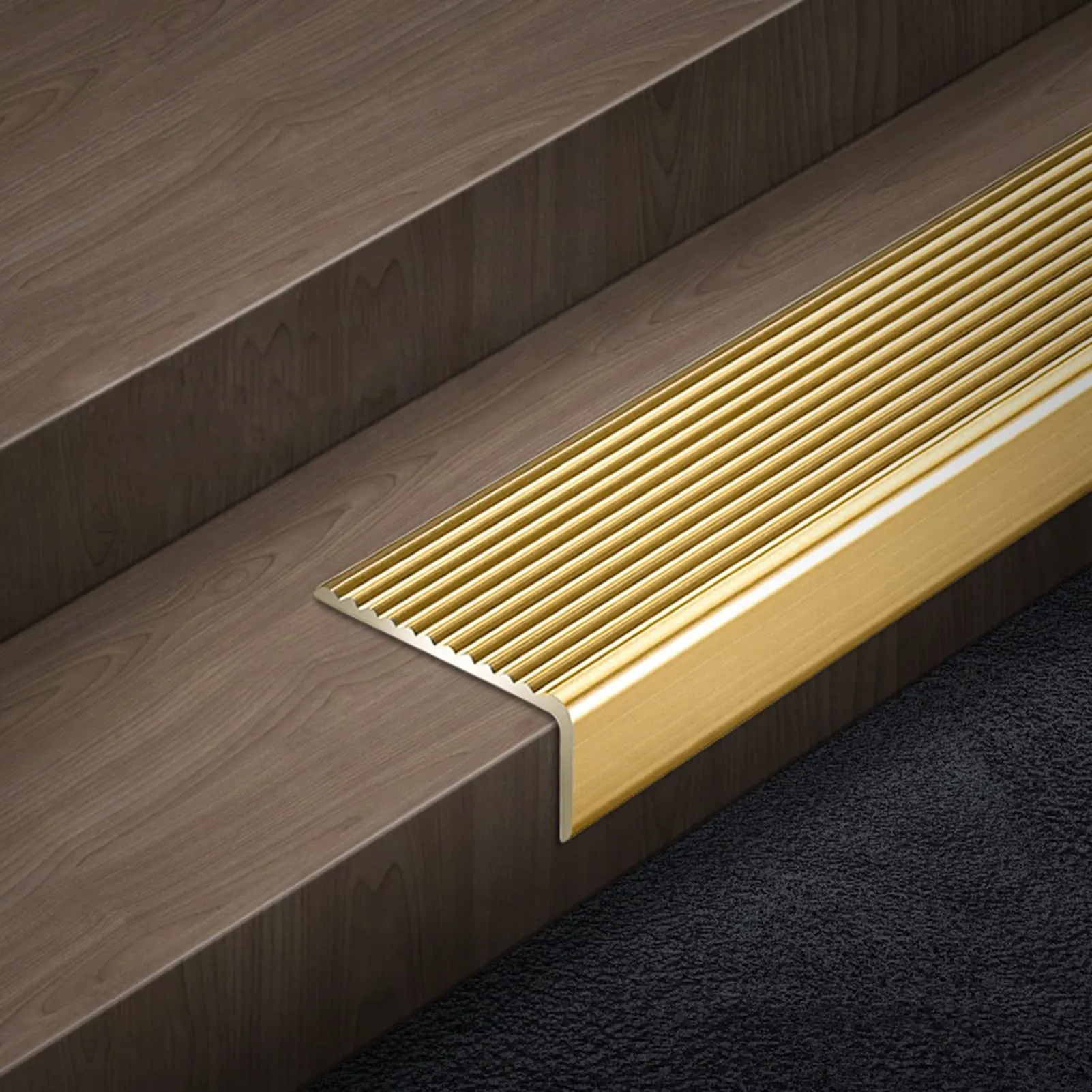
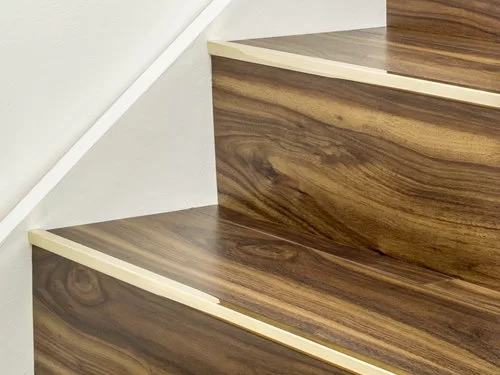
Also, in modern architecture, some people prefer to use brass stair nosing. In high class places like hotels, brass nosing not only enhances the overall look but also adds a touch of class.
>> See Stainless Steel Stair Nosing
Rubber Stair Nosing Types
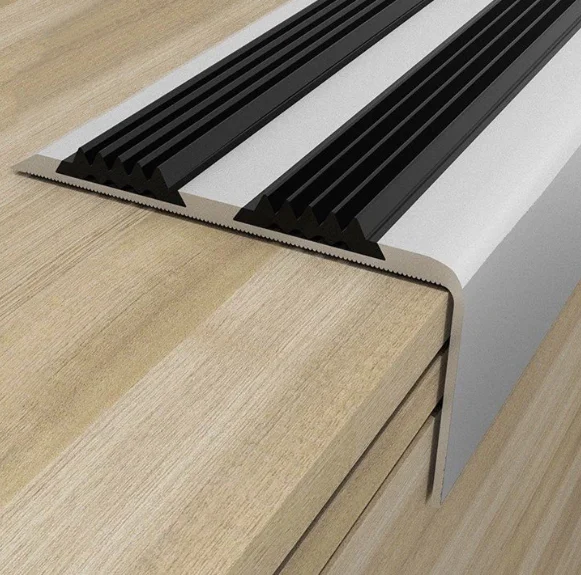
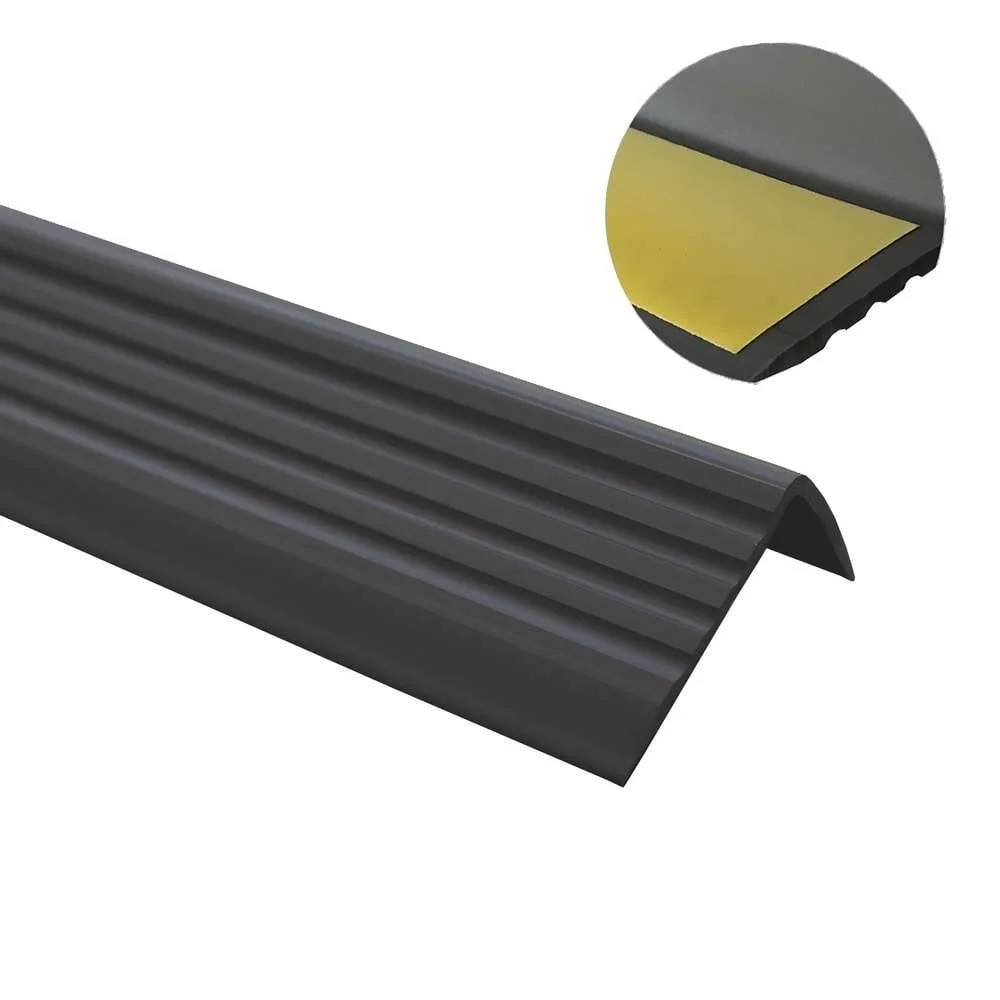
Compared to metal stair nosings, rubber stair nosings have a lower cost. If you are working with a tight budget, they should be a primary consideration.
In terms of slip resistance, rubber stair nosings are better, which due to their natural advantages. Rubber has great friction. Even in wet areas, it can provide excellent slip resistance, preventing individuals from slipping while using the stairs.
PVC or Vinyl Stair Nosing Types


If rubber stair nosings can be considered a natural product, PVC (Polyvinyl Chloride) stair nosings are a modern industrial masterpiece. They not only share the excellent slip resistance of rubber stair nosings but also boast a longer lifespan. The higher level of customization offered by PVC allows for a greater variety of colors and styles, making these stair nosings more adaptable to different architectural aesthetics.
Wood Stair Nosing Types
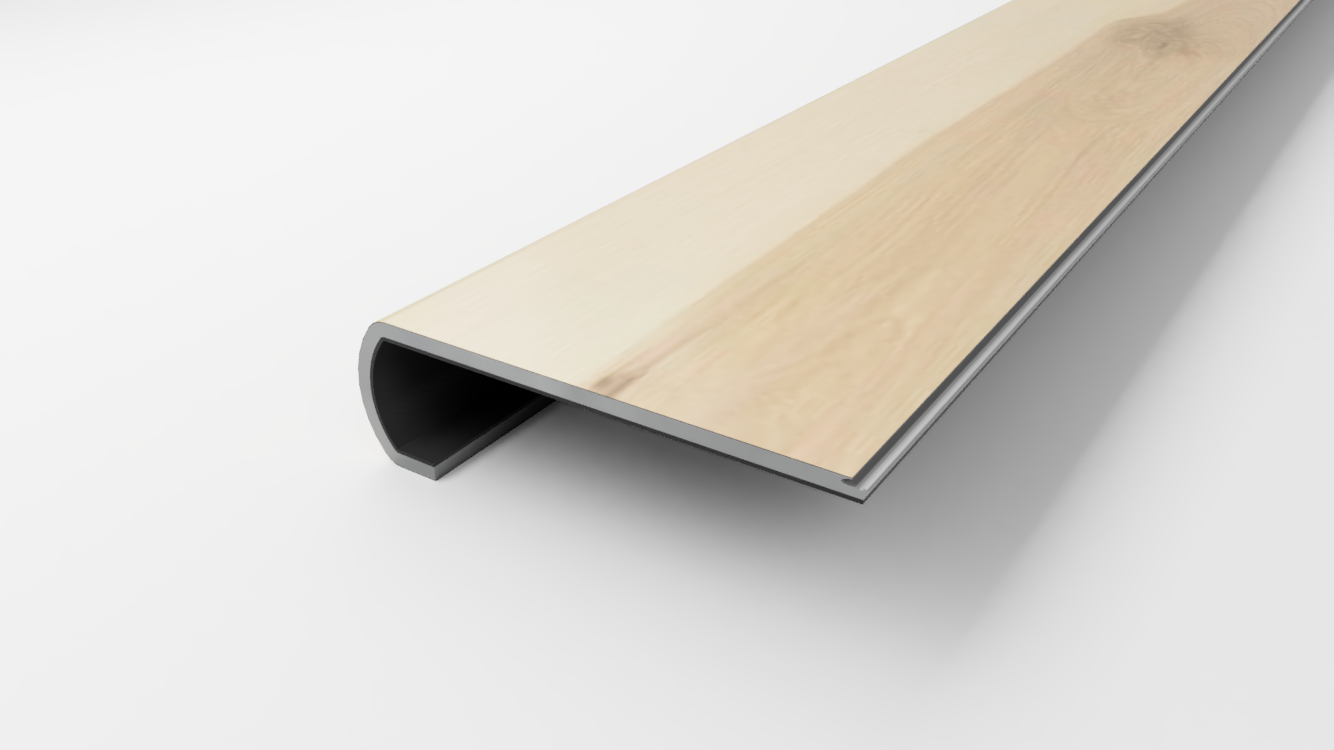
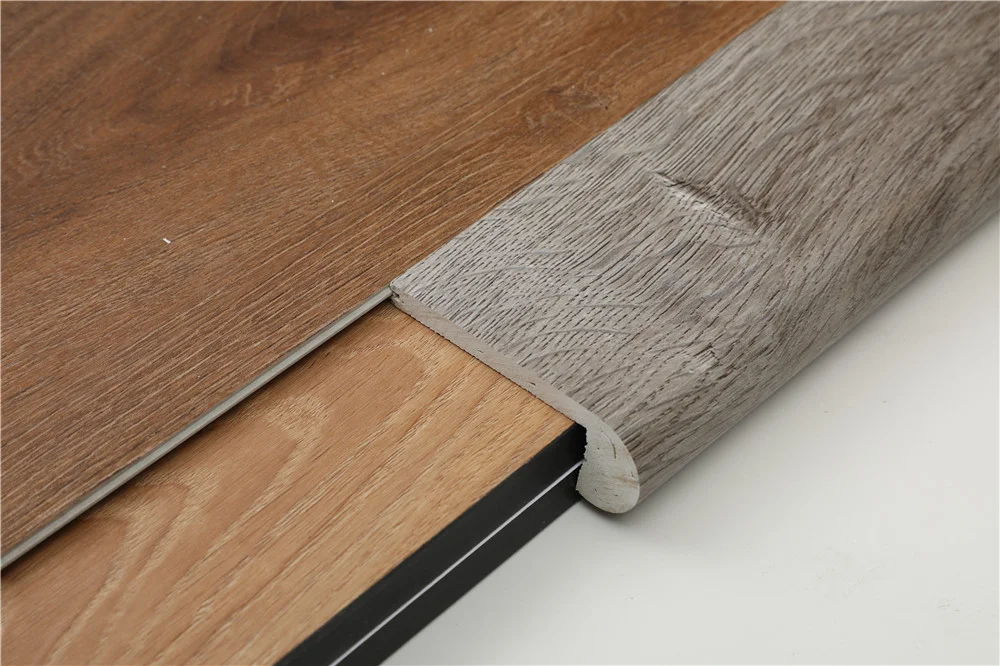
In terms of appearance, a wooden stair nosing is more stylish. Because it gives a feeling of elegance and warmth. Moreover, there are many staircases in buildings are constructed from wood. So, you can use wooden stair nosings contributes to a more unified and coordinated overall style, which is a key reason for their popularity.
However, they do come with some drawbacks. For instance, their lifespan is not as high, and in areas with heavy foot traffic, they are more susceptible to damage such as scratches.
Thickness of the Stair Nosing
Taking into consideration that staircases may be covered with carpeting, it's important to ensure that the stair nosing aligns as much as possible with the floor covering to avoid tripping hazards.
The maximum allowed nosing, as per the requirements outlined by the International Residential Code (IRC), is 1.25 inches.


Adhering to these specifications can help maintain safety and accessibility in stair design, especially when floor coverings like carpets are involved.
By the way, if you don’t want to measure the thickness, you can use Awisdom’s Carpet Stair Nosing. It’s is 100% in line with international stair nosing code.
Slip-Resistance
In comparison to traditional stair nosings, many modern designs come equipped with anti-slip strips, especially in the case of metal stair nosings.
In terms of shape, you can also choose the safer square stair nosings.

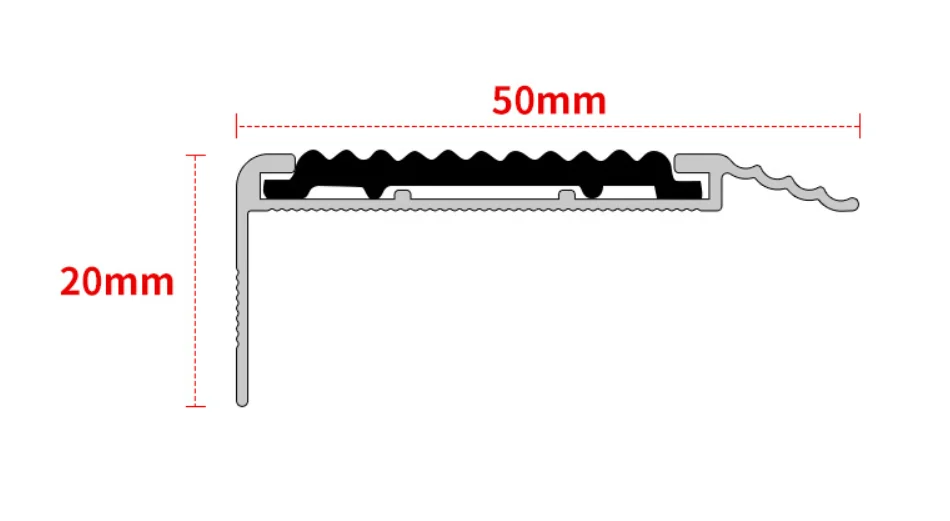
However, it's crucial to pay attention to the Light Reflectance Value (LRV) of the color of the anti-slip strips when choosing nosings with this feature. They should differ from the color of the floor covering or steps by at least 30 points. Additionally, it is advisable to avoid selecting colors that closely resemble the staircase tiles or carpet to enhance visibility and safety.
Ready to Get Your Perfect Stair Nosing?
Now, do you have the best answer in your mind? The choice of stair nosings is certainly not a simple matter. It not only influences aesthetics but is also closely tied to safety.
As a professional architectural accessories manufacturer, Awisdom can provide you with a variety of styles of stair nosings and offer expert guidance. Whether you are in search of a supplier for metal stair nosings or simply want to learn more about the product, feel free to reach out to us. We are here to assist you.
Feel free to click on the links in the table below to quickly browse our products.
Quick View | Alu Nosing Types | Alu Nosing Types | Brass Nosing Types | SS Nosing Types | LED Nosing Types |
|---|---|---|---|---|---|
Types of Nosing |
FAQ about Stair Nosing Types
How to attach stair nosing?
You should involve the following steps when attaching stair nosing :
- Preparation: Clean and level the stairs. If the steps are smooth, roughen them up for better adhesion.
- Measure and Cut: Measure the stair width and cut the nosing strip to fit.
- Test the Fit: Place the strip on the stair tread to test the fit.
- Apply Adhesive: Apply adhesive to the stair nosing and treads, starting from the top step.
- Attach the Nosing: Place the nosing into the adhesive, ensuring it is flush with the riser.
- Secure the Nosing: Secure the nosing with nails or screws if necessary.
- Clean Up: Remove any excess adhesive before it dries.
- Finish: Once the adhesive has dried, finish the nosing to match the stairs.
How to install vinyl stair nosing?
- Measure: Measure the stair width and cut the vinyl stair nosing to fit it.
- Apply Adhesive: Apply a polyurethane adhesive to the underside of the nosing. An "S" shaped bead on the ribbed surface and a straight bead under the stand-off elbow are recommended.
- Attach the Nosing: Carefully position the nosing and press down firmly along the entire stair nose.
- Let Adhesive Cure: Allow the adhesive to cure for at least 4 hours before walking on it. Wait 24-48 hours for full traffic exposure.
What is the difference between stair nose and overlap stair nose?
The main difference between a stair nose and an overlap stair nose is their design and installation. A stair nose, also known as a flush stair nose, provides a smooth transition between the flooring and stair edges, creating clean lines and a streamlined appearance. It is typically installed during the initial construction of the staircase.
On the other hand, an overlap stair nose extends past the edge of the stair tread to cover the seam between the flooring and stairs, and it is often used as a retrofit option for staircase renovations or replacements.
What are the different types of wood nosing?
The different types of wood nosing include:
- Hardwood Species: Wood nosing is available in various hardwood species such as Oak, Cherry, Maple, and Walnut.
- Shapes: There are different shapes of wood nosing, including no overhang, square edge, half-round, and full-round nosing.
- Specialty Options: Some specialty options include bullnose stair nosing, aluminum stair nosing, anti-slip stair nosing, and single or double channel stair nosing.
What is the difference between a tread and a nosing?
The main difference between a tread and a nosing is that the tread is the horizontal surface of the stair that you step on, while the nosing is the portion of the tread that overhangs the front of the riser.

